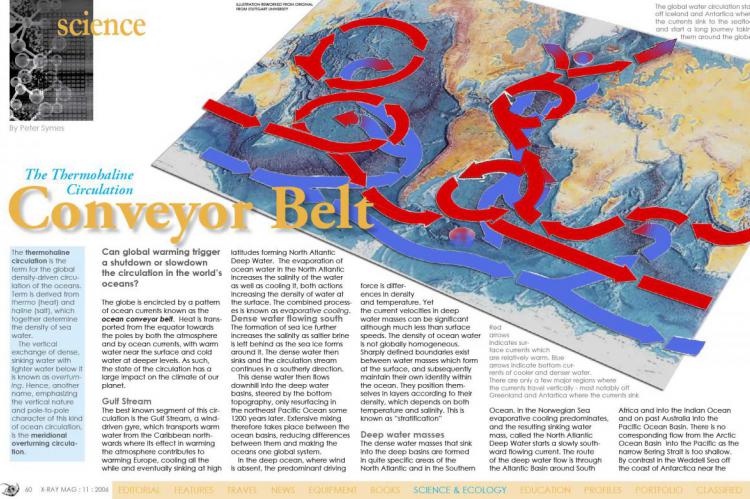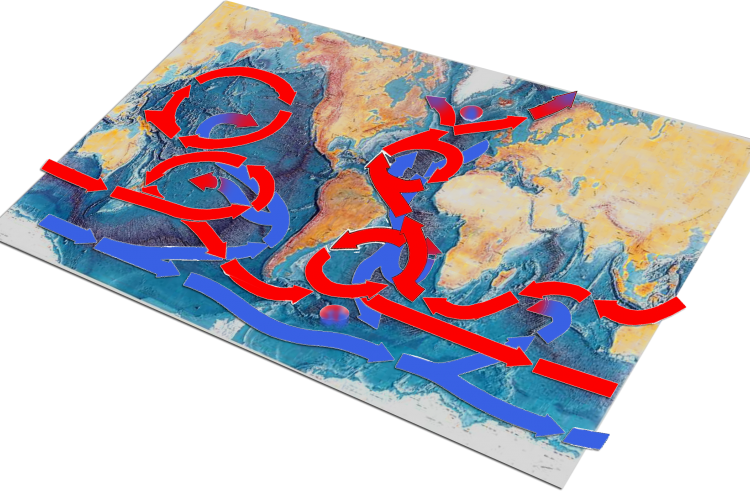Ocean conveyor belt - the thermohaline circulation
Can global warming trigger a shutdown or slowdown the circulation in the world’s oceans?
The globe is encircled by a pattern of ocean currents known as the ocean conveyor belt. Heat is transported from the equator towards the poles by both the atmosphere and by ocean currents, with warm water near the surface and cold water at deeper levels. As such, the state of the circulation has a large impact on the climate of our planet.
Tags & Taxonomy
The thermohaline circulation is the term for the global density-driven circulation of the oceans. Term is derived from thermo (heat) and haline (salt), which together determine the density of sea water. The vertical exchange of dense, sinking water with lighter water below it is known as overturning. Hence, another name, emphasizing the vertical nature and pole-to-pole character of this kind of ocean circulation, is the meridional overturning circulation.
Gulf Stream
The best known segment of this circulation is the Gulf Stream, a wind-driven gyre, which transports warm water from the Caribbean northwards where its effect in warming the atmosphere contributes to warming Europe, cooling all the while and eventually sinking at high latitudes forming North Atlantic Deep Water. The evaporation of ocean water in the North Atlantic increases the salinity of the water as well as cooling it, both actions increasing the density of water at the surface. The combined processes is known as evaporative cooling.
Dense water flowing south
The formation of sea ice further increases the salinity as saltier brine is left behind as the sea ice forms around it. The dense water then sinks and the circulation stream continues in a southerly direction. This dense water then flows downhill into the deep water basins, steered by the bottom topography, only resurfacing in the northeast Pacific Ocean some 1200 years later. Extensive mixing therefore takes place between the ocean basins, reducing differences between them and making the oceans one global system.
In the deep ocean, where wind is absent, the predominant driving force is differences in density and temperature. Yet the current velocities in deep water masses can be significant although much less than surface speeds. The density of ocean water is not globally homogeneous. Sharply defined boundaries exist between water masses which form at the surface, and subsequently maintain their own identity within the ocean. They position themselves in layers according to their density, which depends on both temperature and salinity. This is known as “stratification”
Deep water masses
The dense water masses that sink into the deep basins are formed in quite specific areas of the North Atlantic and in the Southern Ocean. In the Norwegian Sea evaporative cooling predominates, and the resulting sinking water mass, called the North Atlantic Deep Water starts a slowly southward flowing current. The route of the deep water flow is through the Atlantic Basin around South Africa and into the Indian Ocean and on past Australia into the Pacific Ocean Basin. There is no corresponding flow from the Arctic Ocean Basin into the Pacific as the narrow Bering Strait is too shallow.
By contrast in the Weddell Sea off the coast of Antarctica near the edge of the ice pack, the effect the sinking water masses is predominantly caused by brine exclusion when the surface waters freeze. The resulting water mass, the Antarctic Bottom Water, then sinks and flows north into the Atlantic Basin. It is so dense it actually flows under the North Atlantic Deep Water. Once, flow into the Pacific is blocked, this time by the Drake Passage between the Antarctic Peninsula and the southernmost tip of South America forcing the current eastward.
Upwelling
What goes down must come up elsewhere. All these dense water masses sinking into the ocean basins displace the water above them, so that elsewhere water must be rising in order to maintain a balance. However, because this thermohaline upwelling is very widespread and diffuse, it has proven quite tricky to measure where upwelling occurs using current speeds, given all the other wind-driven processes going on in the surface ocean.
Deep waters do however have their own chemical signature and tracking trace elements of silicon from deep water there is clear indications, though not solid evidence, that the bulk of deep upwelling occurs in the North Pacific. A number of other models of ocean circulation place most of the deep upwelling in the Southern Ocean, associated with the strong winds in the open latitudes between South America and Antarctica. ■
Download the full article ⬇︎

Originally published
X-Ray Mag #11
Patagonia, Argentina. El Hierro, the Canary Islands, Coral Bleaching and Global Warming. Crossing the Atlantic on a research vessel. The Conveyor Belt, the oceans global circulation. Building reefs on the Maldives. Cosmetics for Divers. Leigh Cunningham: The Wake-up call. Travelling with Camera Equipment. Japanese wrecks off Palau. Portfolio: Patrick Chevalier.



